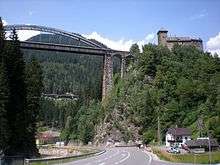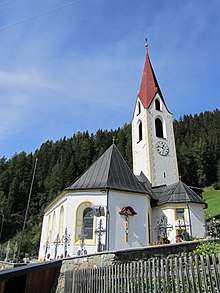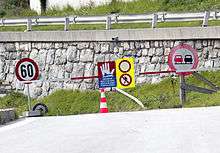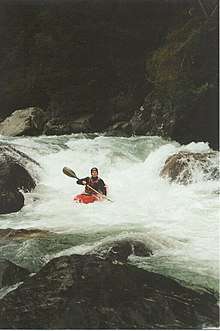Paznaun Valley
The Paznaun Valley (sometimes simply Paznaun for short) is a 40 km long Alpine valley in the south of Tyrol, Austria. It borders Switzerland to the south, Vorarlberg to the west, and the Stanzer Valley to the north and east. With an elevation between 900 and 1800 m, the valley enjoys a lot of snow in winter, and all of its towns and villages have evolved into ski resorts.
Towns and villages
| 🌍
See (See) The first town in the Paznaun Valley. |
| 🌍
Kappl (Durrichalpe, Frödenegg, Inneregg, Kappl, Labebene, Langesthei, Nederle) Best known as ski resort in winter, and for the Wienberg Castle and Trisanna Bridge on the northernmost border of its territory. |
| 🌍
Ischgl (Ischgl, Mathon, Piel, Pirstigalpe, Valzur) Internationally renowned ski resort, and one of the largest in the Alps. |
| 🌍
Galtür (Galtür, Maas, Mühl, Kleinzeinis, Lenzhäuser, Part, Soppen, Tschafein, Unterrain, Wirl) Mountain village at the entrance of the Jamtal. |
Other destinations
- 🌍 Dreiländerspitze (3197 m) — peak at the southernmost point where Tyrol, Vorarlberg and Switzerland meet, ca. 2.5 hours hike from the Jamtalhütte.
Understand
History
Ischgl and Galtür in the upper Paznaun Valley were settled in the 9th century by the Romansh from Engadin, which entered through the 🌍 Fimba Valley (German: Fimbatal) and over the 🌍 Futschöl Pass. The barren valley floor saw only economic use as pastures, for which Ischgl in particular became known by the 11th century. Galtür was populated by Walsers, an Alemannic ethnic group speading out over the alps in the late Middle Ages, settling in the town by the 14th century. The upper Paznaun Valley thus belonged to the county of Lower Engadin and Vinschagu.
The lower towns, See and Kappl, were settled from the north side by settlers from Serfaus and Fiss. They belonged to the Upper Inn Valley ruled by the Duchy of Bavaria and later the court of Landeck. The entire valley falls under control of the court of Landeck since a political treaty of 1868.
Orientation
The Paznaun Valley is in the west of Tyrol, beginning at Pians (Landeck) at the confluence of the Trisanna river which flows through the valley, and the Rosanna. It is a side valley of the Stanzer Valley. The Paznaun Valley is ca. 40 km long and extends from Pians in a south-westerly direction until the 🌍 Bielerhöhe Pass, with the last uninhabited section of the valley past Wirl called the Kleinvermunt. It borders Austrian state Vorarlberg and Switzerland to the south and south-east.
The valley is surrounded by mountains, in the north the Verwallgruppe, and to the south the Samnaungruppe and Silvretta, which gives the valleys ski resort Silvretta Arena its name. The 🌍 Fluchthorn is with 3399 m above sea level the highest peak, and can be seen from nearly everywhere in the valley. Land use in the valley is tailored towards the sun and thus asymmetric: the southern slopes receive a lot of sun and are cultivated with farmland and pastures, whereas the shady northern slopes are covered with pine forests that often reach to the valley floor. The best ski slopes pass through these shady forests.
Climate
| Paznaun Valley | ||||||||||||||||||||||||||||||||||||||||||||||||||||||||||||
|---|---|---|---|---|---|---|---|---|---|---|---|---|---|---|---|---|---|---|---|---|---|---|---|---|---|---|---|---|---|---|---|---|---|---|---|---|---|---|---|---|---|---|---|---|---|---|---|---|---|---|---|---|---|---|---|---|---|---|---|---|
| Climate chart (explanation) | ||||||||||||||||||||||||||||||||||||||||||||||||||||||||||||
| ||||||||||||||||||||||||||||||||||||||||||||||||||||||||||||
| ||||||||||||||||||||||||||||||||||||||||||||||||||||||||||||
The Paznaun Valley has a typical climate of central Alpine high valleys, which due to the altitude is cold but on average sunnier than northerly valleys like the Lower Inn Valley. It also receives less precipitation (unfortunately also less snow in winter) than valleys further north or south. The best times of the year to visit are from January until early March when the chance of rain or snow is lowest and there is already substantial snow on the ground, or in July or August when temperatures are the highest -- but also chance of rain. Water proof clothing is a must when visiting the Paznaun Valley in any season.
Get in
By bus
All villages and towns in the Paznaun Valley are connected twice per hour in each direction by bus 260 travelling between Wirl and 🌍 Landeck-Zams bus station where it departs from platform C. A ticket from Landeck-Zams bus station to the end of the valley costs €9.30.
By train
There is no railway infrastructure in the Paznaun Valley itself, but the Arlbergbahn railway passes through Landeck at the 🌍 entrance of the valley. Take the train to 🌍 Landeck-Zams station. Landeck-Zams has direct railway connections to St. Anton, Bludenz, Feldkirch, Buchs, Imst, Ötz Valley, Telfs, Zirl, and Innsbruck. The journey from Innsbruck takes ca. 40 minutes.
By plane
The closest airport is 🌍 Innsbruck Airport, ca. 100 km to the north-east. From the airport, take bus F to 🌍 Innsbruck Hbf (Main Station), a ticket costs €2.40. From the Main Station, take the train to Landeck-Zams station.
The second nearest airport is 🌍 Munich Airport in Bavaria, Germany. There are high speed rail connections from Munich to Innsbruck, where a transfer to a local train to Landeck is required.
By ski
A more adventurous way to get into the valley is over the mountain ridge between the 🌍 Flimspitze (2929 m) and the 🌍 Salaaserkopf (2744 m), which forms the border between Austria and Switzerland. There is lift infrastructure taking skiers to the ridge from Ischgl on the Austrian side, and from 🌍 Ravaisch on the Swiss side, as their shared ski resort spans both towns across the border.
Get around
There is no railway infrastructure in the Paznaun Valley, so the only way to get around is by ski or by road. The major highway is the Silvrettastraße, also the only snow cleared road in the valley, which runs from a few km west of Landeck all the way up to Wirl.
Bus 260 connects all villages and towns in the Paznaun Valley to Landeck, at least once per hour in each direction. Travel time from Landeck to the end of the Paznaun Valley is ca. 75 minutes, and a ticket costs €8.50.
See
If the breathtaking landscape isn't enough to see, then the valley also offers architectural and cultural gems to explore. The 🌍 Alpinarium in Galtür is a good start to explore the valley's rich history, and the dangers posed by avalanches in the Alps. As threatening as they can be, these very same mountains are also responsible for the valley's prosperity in ancient times as evidenced by the 🌍 Gugger Mill which was one of the first applications of water power in the valley. More recently, the rise of tourism since the 1960s makes full use of the Silvretta mountain range, and the 🌍 Ropeway Museum in Ischgl gives a good idea of the technical challenges involved in taming the mountains for winter sports purposes. For the less technical but more artistic of mind, the 🌍 Mathias Schmid Museum gives an insight in fine arts in the valley during the 20th century.

The valley's strategic importance has made it into a battleground many times throughout history, and 🌍 Wiesberg Castle at the entrance of the valley is one of the best preserved fortifications worth a visit. Don't forget to take a look at the nearby 🌍 Trisanna Bridge, a nice example of late 19th century civil engineering, and after modifications in the 20th century still in use as a railway bridge. Its 120 m long steel arch made it one of the most easily recognizable landmarks of the Paznaun Valley.

A region with strong traditions and religious ties to Christianity, it won't surprise that there are over 50 churches, chapels and shrines scattered throughout the valley. The 🌍 St. Sebastian Church in See and 🌍 St. Hieronymus Church in Kappl are examples of Baroque religious architecture, enhanced with a Gothic bell tower. Some of the chapels are true architectural gems hidden deep in the woods, and might require a climb of a few hours. A fine example is the 🌍 Chapel of the Seven Sorrows of Mary, but nearly all chapels and shrines in the Paznaun Valley are well maintained and worth taking a look inside if encountered on hiking trails.
Silvretta Card
Many hotels in the Paznaun Valley offer guests a free Silvretta Card, with numerous benefits for activities in the valley:
- Free use of all ski lifts and rope ways in the Panzaun Valley and in Samnaun
- Free use of public transport in Paznaun and the Bielerhöhe
- Free admission to the indoor and outdoor swimming pools of Ischgl and Galtür
- Free admission to the play-, sports- and water park in See
- Free admission to the Alpinarium and Ropeway Museum
- Toll-free use of the Silvrettastrasse if you choose to visit with a motorized vehicle
- Discount on motorbike hire at the High Bike Testcenter
If you plan to make use of these facilities, choosing accommodation that offers you a free Silvretta Card can make your stay a lot cheaper.
Do
Winter sports
The high elevation of the valley and proximity to the Silvretta Group mountain range with peaks up to 3000 m give skiers ample opportunities for winter sports activities. The 4 towns (See, Kappl, Ischgl, and Galtür) each have their own ski resort of which Ischgl is by far the largest and most modern. It is possible to buy a ski pass that gives access to all ski infrastructure in the entire valley and in Samnaun. A 6-day pass costs €266,50 for adults, €160,00 for children, and €240 for seniors (2018 - 2019 season).
Name Tel. Altitude 





See in Tyrol +43 50 990 400 1040 - 2456 m 7 Lifts: 2 / 2 / 3 41 km Pistes: 8 / 25 / 8 Ski Resort Kappl +43 50 990 300 1180 - 2690 m 6 Lifts: 1 / 3 / 2 40 km Pistes: 10 / 25 / 5 Silvretta Arena +43 50 990 100 1377 - 2872 m 41 Lifts: 7 / 25 / 9 239 km Pistes: 47 / 143 / 49 Silvapark +43 50 990 200 1600 - 2300 m 10 Lifts: 2 / 2 / 6 43 km Pistes: 6 / 25 / 12 8
Eat
The valley is known for its hard cheese, made from untreated milk produced by cattle grazing the pastures in the valley. It is made in the 🌍 Dorfsennerei in See and in 🌍 Hofkäserei Huber in Galtür. The most popular varieties are the Sennerkäse (35% fat), Bergkäse (45% fat) and Schmuggler (50% fat). Less common but also worth a try are Graukase (literally gray cheese) and goat cheese (German: Ziegekäse).
Sausages and bacon are very popular and produced locally in many varieties, some of which also for sale in the Dorfsennerei in See. Tiroler Speck (Tyrolean bacon)) is a delicacy and found nearly everywhere.
Wild flowers in pastures produce the delicious Paznauner Gebirgsblüten Honig, honey with a distinctly rich flavour. 🌍 Marcel Prinoth is one of the valley's most famous beekeepers and sells the honey in Ischgl where it is served in many of the local restaurants.
Drink
Ice cold glacier water!
Sleep
With an economy tailored to tourism, there is no lack of accommodation in the Paznaun Valley. Hotels in the centre of the major towns tend to be the most expensive, followed by hotels in the vicinity of ski bus stops — all which aim for a winter sports audience and are more expensive in winter than in summer.
Cheaper hotels can be found along the Silvrettastraße connecting the towns, and in smaller suburbs further away from ski infrastructure. There is a good selection of apartments available for rent, but AirBnB style bed and breakfast are few and far between. If you plan on visiting in the winter season, when tens of thousands of skiers flock to the Paznaun Valley, it is paramount to arrange accommodation well in advance. Making a hotel reservation 4 to 6 months prior to your visit is not unusual if you want to secure the best value for money.
The 🌍 Zeinissee camping grounds near the reservoir (German: Stausee) is only reachable from Galtür although administratively in Vorarlberg. Although closed in winter and inaccessible over the road, it offers a more budget friendly accommodation option for hikers in the summer months.
Cope
If pets get ill or injured, a veterinary practice is available in Kappl:
- 🌍 Ludwig Pfund, Egger Weg 311, 6555 Kappl, ☎ +43 5445 6268, fax: +43 5445 20031. Widely considered one of the best vets in the valley.
Stay safe

The steep mountain slopes cause frequent avalanches and mud flows in the valley. The 1999 avalanche of Galtür was particularly deadly, with 38 deaths in and around the town, but also smaller avalanches occasionally cost lives of skiers or residents. Since the 1999 disaster, over 12.6 M€ was spent on avalanche mitigation engineering, including fences and dams. Avalanches are inherently unpredictable however, so although the risk can be reduced, it can never be completely eliminated. When skiing, do not leave marked trails (except for the so-called ski routes), and observe avalanche alert systems. The Silvrettastraße can occasionally be closed because of the avalanche risk (German: Lawinengefahr), cutting parts of the Paznaun Valley off from the rest of the world.
There is little crime in the valley, but pickpockets are not unheard of. Particularly in Ischgl, known for attracting youngsters to its nightlife, incidents do occur with drunk patrons in the early morning hours. In case incidents occur, there is a police station in Kappl:
- 🌍 Police Kappl (Polizeiinspektion Kappl), Höferau 445, 6555 Kappl, ☎ +43 59133 7143100, fax: +43 59133 7143109, e-mail: PI-T-Kappl@polizei.gv.at.
Stay healthy
There are several doctors and pharmacies in the valley:
- 🌍 Dr. Forian Jehle, Dorf 112, 6555 Kappl (next to the church), ☎ +43 5445 6230, e-mail: manuel.mau@icloud.com. M-F 08:30-11:00, 14:00-15:30. Doctor and pharmacy with 24/7 emergency service.
- 🌍 Dr. Andreas Walser (Arzt Praxis Dr. Walser Andreas), Silvrettaplatz 1, 6561 Ischgl, ☎ +43 5444 52000, e-mail: drandreas.walser@a1.net. M-F 08:00-11:30, 15:00-17:30, Sa-Su 09:30-11:30.
Go next
- 🌍 Landeck — rail transport hub in the Arlberg region.
- 🌍 St. Anton — one of the most popular ski resorts in Austria, serviced by the Orient Express.
- Lower Inn Valley
